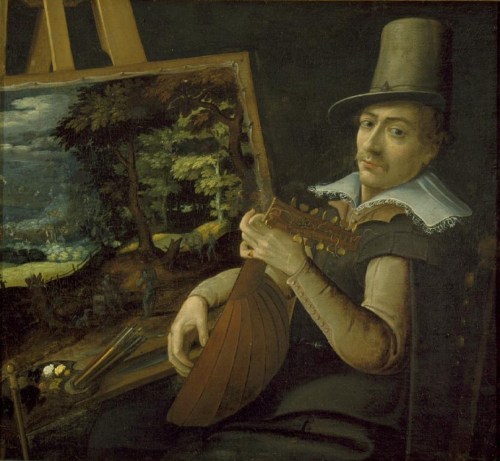 Artist: Paul Bril (circa 1553/1554–1626)
Artist: Paul Bril (circa 1553/1554–1626)
Title: Self-portrait
Genre: self-portrait
Date: between 1595 and 1600
Medium: oil on canvas
Dimensions: Height: 71 cm (27.9 in); Width: 78 cm (30.7 in)
About this painting, via Wikipedia:
The painting portrays the artist, elegantly dressed and holding a lute, sitting before his palette and easel, on which a landscape painting sits.
Bril is seen from the back, and is turning towards the viewer. He grasps the lute firmly, with active and jointed fingers. The landscape painting sitting on the easel is typical of Bril’s early work which is characterized by small figures, deep and shaded foregrounds and masses of silvery foliage, attributes that [Bril] shared with other Flemish painters. This has helped with the dating of the work to ca. 1595 – 1600. [1]
What I love about this image:
In this self-portrait Bril shows the viewer who he is and what he cares about, art and music. He is relaxed, at peace and sharing his two passions with us.
Credits and Attributions:
Paul Brill, Public domain, via Wikimedia Commons
[1] Wikipedia contributors, “Self-Portrait (Paul Bril),” Wikipedia, The Free Encyclopedia, https://en.wikipedia.org/w/index.php?title=Self-Portrait_(Paul_Bril)&oldid=1008810469 (accessed February 26, 2021).
Wikimedia Commons contributors, “File:Bril, Paul – Self-Portrait – 1595-1600.jpg,” Wikimedia Commons, the free media repository, https://commons.wikimedia.org/w/index.php?title=File:Bril,_Paul_-_Self-Portrait_-_1595-1600.jpg&oldid=527757876 (accessed February 26, 2021).

![Rembrandt Peale [Public domain] via Wikimedia Commons](https://conniejjasperson.com/wp-content/uploads/2019/02/rembrandt_peale_self-portrait.jpg?w=500)






